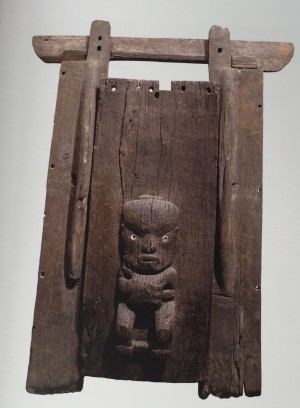
This carved door belonged to a semi-subterranean storage pit from Omaramutu, Opotiki and contextualises itself within the period Te Puawaitanga (The Flowering, 1500-1800 AD) in relation to New Zealand art history (Anderson 97), which can also be acknowledged as the Traditional Phase (Anderson 73). Due to the increase in population, there became “a growing demand during the Traditionalist phase for new items representing wealth and status” (Anderson 91). Protection of food resources and seeds was of great concern to Maori, so it was essential for them to portray their Pa site in a way that represented power and success, as they were often a visible landmark (Anderson 94). Long distance communication became less frequent due to territorialism and the increase of population, which enable communities to develop their own unique carving styles (Anderson 86). The curvilinear style of South Polynesia became the popular carving technique in contrast to East Polynesian rectilinear style (Anderson 87) and can be seen in the figure on the Omaramutu storage pit door. The dominant figure on the door appears fierce and the paua shell eyes pierce through the viewer. It is fair to conclude that this piece of art presents a sense of mana, as the storage pit would’ve been considered toanga.
Works Cited:
Anderson, Atholl, Judith Binney, and Aroha Harris. “Pieces of the Past.” Tangata Whenua: An Illustrated History. New Zealand: Bridget Williams Books, 2012. 70-101. Print.